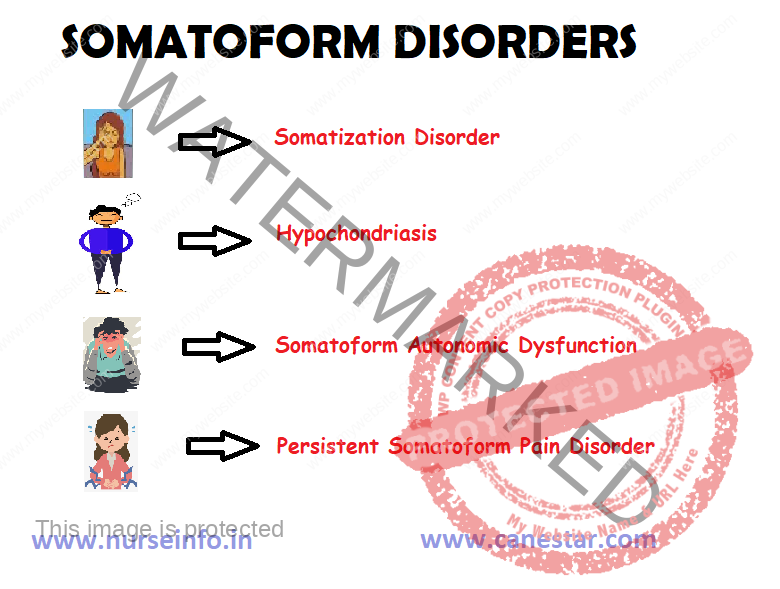SOMATOFORM DISORDERS – Types, Diagnoses and Treatment
These disorders are characterized by repeated presentation with physical symptoms which do not have any physical basis, and a persistent request for investigations and treatment despite repeated assurance by the treating doctors. In these disorders, manifestation of physical symptoms is caused by psychological distress.
These disorders are divided into following categories:
- Somatization disorder
- Hypochondriasis
- Somatoform autonomic dysfunction
- Persistent somatoform pain disorder
Somatization Disorder:
Somatization disorder is characterized by chronic multiple somatic symptoms in the absence of physical disorder. The symptoms are vague, presented in a dramatic manner and involve multiple organ systems.
Common Signs and Symptoms of Somatization Disorder
- Multiple somatic complaints, unexplained by medical findings
- Complaints of pain in at least four different locations
- Two gastrointestinal, one sexual or reproductive and one neurologic symptom
- Moderate to severe anxiety
- Inability to voluntarily control the symptoms
- Dependency with demanding, attention getting behaviors
- Secondary gain
- Significant distress or impairment in social or occupational areas
Hypochondriasis
Hypochondriasis is defined as a persistent preoccupation with a fear of belief of having a serious disease despite repeated medical reassurance
Common Signs and Symptoms of Hypocondriasis
- Fear or preoccupation with body functioning misperceived as a major illness
- Repeated healthcare visits seeking verification of fear (doctor shopping)
- Symptoms reported in specific detail
- Involvement of one or more body systems
- Unconvinced by repeated examinations, investigations and reassurance that disease does not exist
- Impaired social and family relationships
Somatoform Autonomic Dysfunction
In this disorder, the symptoms are predominantly under autonomic control, as if they were due to a physical disorder. Some of them include palpitations, hiccoughs, hyperventilation, irritable bowel, dysuria etc.
Persistent Somatoform Pain Disorder
The main feature of this disorder is severe, persistent pain without any physical basis. It may be of sufficient severity so as to cause social or occupational impairment. Preoccupation with the pain is common.
DIAGNOSES
- Physical workup to rule out medical and neurologic conditions
- Complete patient history with emphasis on current psychological stressors
- Tests to rule out underlying organic disease
TREATMENT MODALITIES
Drug Therapy:
- Antidepressants
- Benzodiazepines
Psychological Treatment
- Supportive Psychotherapy
- Relaxation Therapy
NURSING INTERVENTIONS (SOMATOFORM)
- Before a somatoform determination, a physical examination and diagnostic testing are necessary to rule out any underlying pathology
- Create an accepting safe and supportive atmosphere that allows open communication with the patient
- Should focus on the whole person, including psychological, social and family factors in addition to the physical symptoms
- It must be remembered that they are not consciously trying to be sick or avoid responsibilities
- Respond to patient with understanding and patience
- Identify types of primary and secondary gain achieved by symptoms
- Minimize time and attention given to physical symptoms
- Encourage patient to keep a diary of daily happenings and feelings, along with physical symptoms
- Encourage the patient to make decisions and take responsibility for situations related to them
- Help the patient to identify more effective coping mechanisms rather than the somatic syndromes
OTHER NEUROTIC DISORDERS
According to ICD10, the other neurotic disorders are neurasthenia, depersonalization-derealization syndrome and culture bound syndromes
Neurasthenia
It is characterized by persisting and distressing complaints of increased fatigue after mental or physical effort
Depersonalization
It is characterized by an alternation in the perception or experience of self, so that the feeling of one’s own reality is temporarily changed or lost
Derealization
It is an alternation in the perception or experience of the external world, so that the feeling of reality of external world is temporarily changed or lost
Dhat Syndrome
It is a culture-bound syndrome, which is prevalent in the Indian Subcontinent, characterized by complaint of passage of whitish discharge (Dhat) in urine, multiple somatic symptoms, physical or mental exhaustion, anxiety or depression and sexual dysfunction.
Treatment
- Supportive Psychotherapy
- Counseling
- Antidepressants


